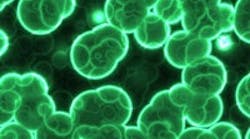With their high oil and sugar content, fast growth rate, suitability for marginal land and low demands on freshwater compared with food crops, algae are increasingly being promoted as a suitable feedstock for a wide range of products.
[pullquote]
According to the Algae Biomass Organization (ABO), Preston, Minn., 23 projects currently are underway around the world highlighting the multi-faceted promise of algae.
In February, Cereplast, El Segundo, Calif., set up a subsidiary called Algaeplast to focus on the development and manufacture of algae-based bioplastics. Cereplast also commercialized biopropylene 109D last December.
And Dordan, Woodstock, Ill., has introduced the first-ever thermoformed sample of a bioresin that uses Algae-Plastic created by AlGIX, Bogart, Ga. Dordan says that production at large enough scale could make this material a viable option for those looking for a cost-competitive, bio-based and thermoformable resin.
On a national scale, the U.S. Department of Energy's Office of Energy Efficiency and Renewable Energy (OEERE) recently announced a funding opportunity focused on supporting research to improve the yield of algae-based biofuel feedstock to 2,500 gallons per acre by 2018 and 5,000 gallons per acre by 2022 — a level the DOE believes will be cost-competitive with other fuel sources.
To achieve this, the OEERE is focused on three main areas. The first is improving algal biomass productivity. Here, research aims to accelerate the development of promising algal strains and cultivation techniques that will increase algal biomass productivity in outdoor cultivation environments.
Second, is improving pre-processing technologies. This involves research and engineering to build and operate innovative harvesting, dewatering, and intermediate processing unit operations that can be integrated at scale, operate in an energy-efficient manner, and are low cost.
The final topic focuses on technical advances that enable integration of algal biomass unit operations. This research aims to ensure that the integrated biofuel system is capable of meeting target yields and can be scaled and operated to produce cost-competitive fuels and products.
Meanwhile in Europe, preparations are underway for an "Algae Day" session at the European Union's upcoming 21st European Biomass Conference and Exhibition in Copenhagen, Denmark, from June 3–7. The session will include an update on progress being made within two European-funded projects focused on advancing the algal biotechnology marketplace.
The first, called EnAlgae, is a four-year strategic initiative to reduce carbon dioxide emissions and dependency on unsustainable energy sources in Northwest Europe.
The project is developing sustainable technologies for algal biomass production, bioenergy and greenhouse-gas mitigation, taking them from pilot facilities through to market-place products and services. Nine pilot-scale facilities will be developed and shared across the territory to potentially help overcome cost and access barriers.
In fact, cost issues took center stage at a key EnAlgae stakeholders' meeting on January 21. Delegates were urged to experiment with the open source Excel economic model the project is using to better compare data outputs from different companies.
"The model supports the theory that an integrated biorefinery approach is key to creating a viable algal bioenergy market. Scale is a crucial factor in reducing cost-per-kilo and finding ways to improve energy efficiency will make the greatest impact on the overall cost of algal biomass. A good example of an area where improvements might be possible is the cost of electricity for pumping and mixing; at present, according to the EnAlgae model, this can add almost €3 ($4) per kilo to the price," notes Dr. Brenda Parker, algal technology and biorefining expert with InCrops, a non-profit company based at the University of East Anglia, Norwich, U.K. InCrops focuses on developing and commercializing new biorenewable feedstocks.
Now that the model's foundation has been built, work has begun on the economic modeling of closed growth systems. There will be more on this at the June meeting.
The second project, called ALGADISK, will develop a modular, scalable and automatic biofilm reactor for algae biomass production, with low operational and installation costs.
The reactor will capture carbon from industrial emissions to produce high-value organic products. In this system, algae will be grown both in an aqueous environment and on biocompatible surfaces, allowing for carbon absorption from either the gas or liquid phase. The laboratory-scale reactor needed to test the control system and the harvesting options already have been constructed.

Seán Ottewell is Chemical Processing's Editor at Large. You can e-mail him at [email protected].
Latest from Environmental Health & Safety
Latest from Environmental Health & Safety
